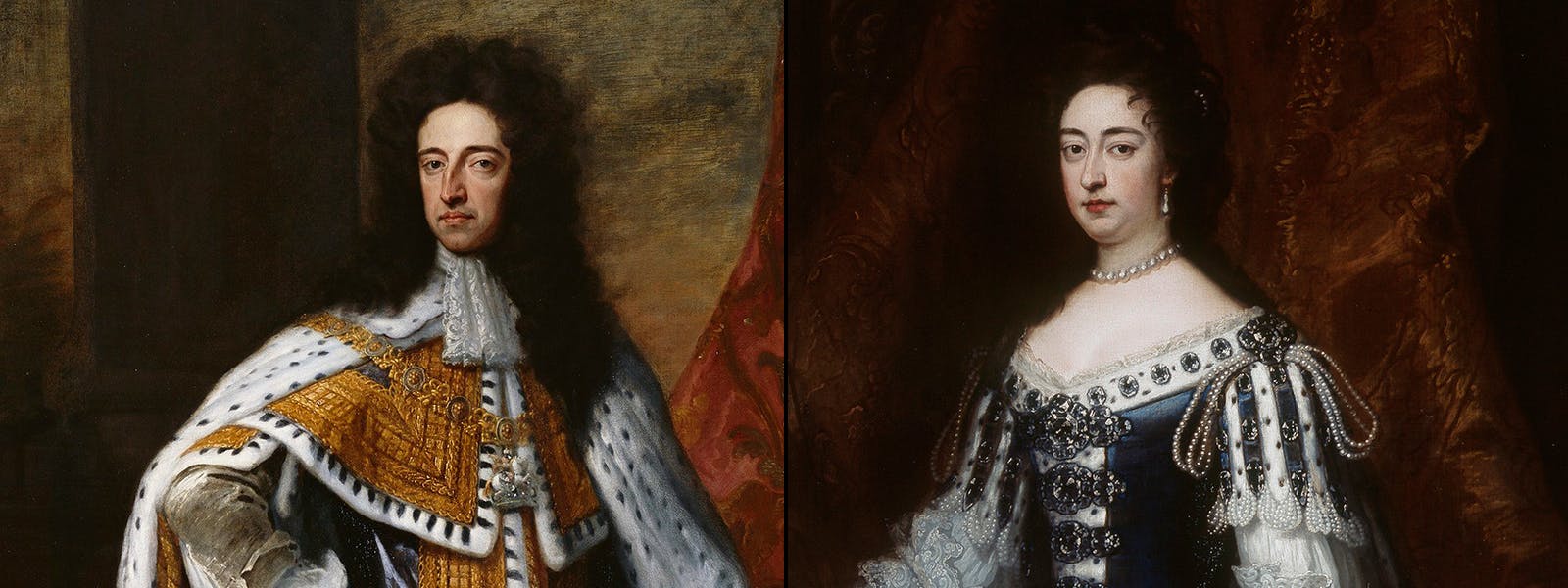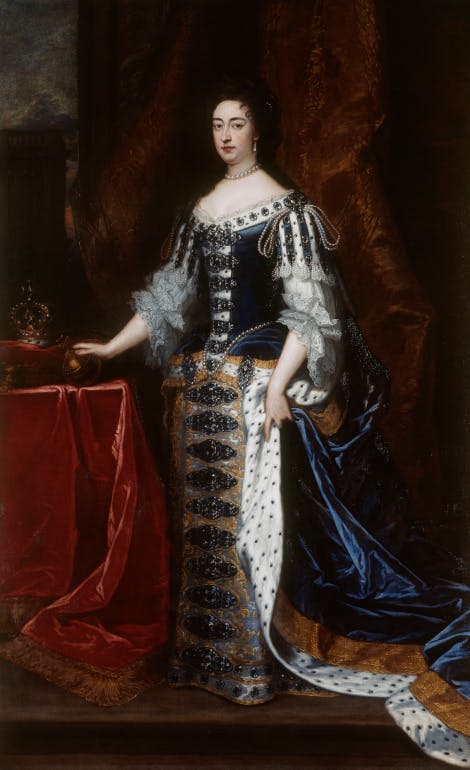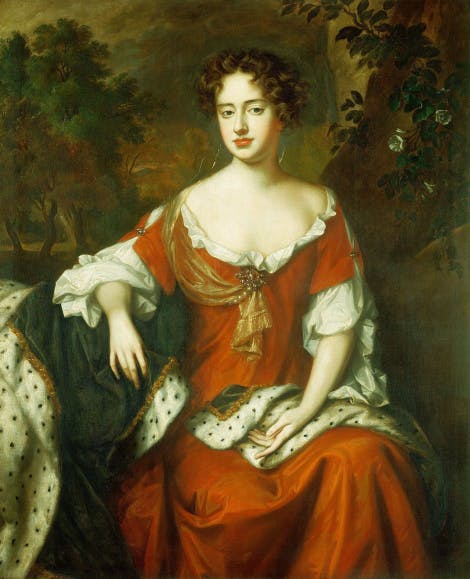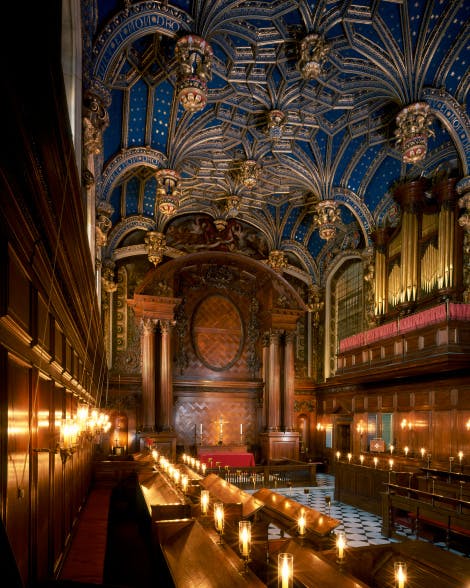
This royal couple transformed Kensington Palace into a royal residence
William III and Mary II were England’s first and only joint sovereigns. They shared equal status and power from 1689 until Mary’s death in 1694.
William and Mary, both Protestants, came to the throne after the "Glorious Revolution" of 1688; Mary’s father, James II, was deposed for trying to enforce Catholic tolerance in England.
The Stuart dynasty
William and Mary were cousins, sharing King Charles I and Queen Henrietta Maria as grandparents.
Mary was the daughter of Charles I's youngest son, James II and his first wife, Anne Hyde. Her sister, Queen Anne succeeded to the English throne after William's death.
William was the son of Charles I's daughter, Princess Mary and William II, Prince of Orange, in the present-day Netherlands. The House of Orange-Nassau remains the reigning house in the Netherlands today.
Header image: A pair of portraits of William III and Mary II by Sir Godfrey Kneller, 1690. The portraits were hanging in the Council Chamber at Kensington Palace by 1697. Royal Collection Trust / © His Majesty King Charles III 2024

Image: The arrival of William III and Mary II at Whitehall in 1688. The Banqueting House and Whitehall Palace can be seen in the background. © Historic Royal Palaces
William and Mary's childhood and education
Mary's early life
Mary was born at St. James's Palace in London on 30 April 1662. Her mother died from breast cancer in 1671 at the age of 34. Mary lived much of her childhood at Richmond Palace under the guidance of a governess, Lady Frances Villiers, and her upbringing was carefully monitored because of fears around her parents' Catholic sympathies.
A small team of bishops provided for Mary’s education, and she became a devoted and knowledgeable member of the Church of England.
William's early life
William was born at Binnenhof Palace in the Hague on 14 December 1650. His father, William II, Princes of Orange and Stadtholder (steward) of Holland, died from smallpox, eight days before he was born.
William was raised by a series of governesses including Lady Anna Mackenzie, a Scottish noblewoman whose family had been ruined by their tireless support of the Stuart royal cause. He was also visited by his uncle, Charles II of England.
William was educated by Dutch Calvinist theologian Cornelis Trigland, and received additional education from Hendrik Bornius, who was a Professor of Ethics at Leiden University.
Read more: Queen Anne
William and Mary's marriage
Mary’s marriage prospects, as a potential future heir to the English throne, had been hotly debated since she was a young child. Charles I favoured the match with Protestant William of Orange, and his brother James was pressured to consent.
William and Mary were married on 4 November 1677, aged 15 and 26 respectively. The wedding took place in Mary’s bedchamber at St James’s Palace. Mary was given away by her uncle Charles II, rather than by her father.
Life in the Netherlands
Mary reluctantly left for the Netherlands on 28 November 1677. The couple’s relationship was initially difficult, in no small part due to William’s irritable and ungracious personality. However, Mary was compelled to be devoted to her husband by her religion, as well as family and social expectations.
William had gained a reputation as a courageous and risk-taking soldier, who was committed to the duties of leadership. His military endeavours often took him away and their separation caused Mary much distress.
Mary kept busy integrating with Dutch and European high society and increasing her collections of jewellery, perfume, porcelain, and other luxury goods. She was also committed to reading and attending to her religious devotions.
Mary particularly looked forward to visits from her English relatives, especially her sister Anne.
Personal lives
Mary endured two miscarriages in the spring and autumn of 1678. The couple never produced an heir.
If one could hinder oneself setting one’s heart too much upon those we love, we should be the readier to die.
Mary, in a letter to a friend who had lost a child
William's infidelity
Not long after her miscarriages, William is suspected of taking Elizabeth Villiers, one of Mary's ladies-in-waiting, as his mistress.
Elizabeth was daughter to Frances Villiers, Mary's former Governess. Mistresses were not uncommon in the English Court. Elizabeth's cousin, Barbara Villiers, was mistress to Charles II. Her uncle, George Villiers, Duke of Buckingham had been a favourite and perhaps lover of James I.
Mary did not confront William about his infidelity for many years. Her chief concern seems to have been the adverse impact on his spiritual health.
William III also had many male royal favourites on whom he lavished attention and patronage. Some contemporaries and historians suspected these relationships may have been romantic in nature.

Image: William III by Sir Godfrey Kneller, 1690. Royal Collection Trust / © His Majesty King Charles III 2024
The "Glorious Revolution"
William III and Mary II's route to the throne
Following the death of Mary's uncle Charles II in 1685, her father became King James II of England and James VII of Scotland.
As a Catholic, James sought greater tolerance for Catholics in England. This caused considerable anxiety; at this time, England was predominantly Protestant.
James II was the first English monarch since Henry VIII's Reformation to send an envoy to the Pope in Rome. Fears grew that the King would emulate the position in France, where religious intolerance was forcing Protestants into exile.
William invades England
In June 1688, James II's wife, Mary Beatrice of Modena gave birth to a son. This posed a serious challenge to Mary’s succession to the English throne.
William hatched a plan to invade England with a Protestant army, to secure Mary’s inheritance and halt James’s Catholic ambitions. He was anxious that England remain an important Protestant ally for the Netherlands.
William landed in England in November 1688, with a huge Protestant army and the support of James II's English opponents.
James II fled to France, which Parliament declared an abdication on 13 February 1689. The reign of William III and Mary II had begun.
Did you know?
James II and Mary Beatrice's son, James Francis Edward Stuart, would later be known as the "Old Pretender".
What is the "Glorious Revolution"?
The term "Glorious Revolution" is often used to distinguish the events preceding William and Mary's reign from comparatively bloody transfers of power. However, its use in this way fails to recognise that they were far from bloodless outside of England.
In Ireland, the change in monarchy involved a series of fierce battles between James and William, and their supporters, which continued until 1691.
The terms "War of the Two Kings" and "Williamite War" recognise the violent nature of these events beyond English shores.
A unique coronation
William III and Mary II were crowned as joint monarchs on 11 April 1689 in Westminster Abbey.
The ceremony was conducted by the Archbishop of London; the Archbishop of Canterbury refused to participate because he had already sworn allegiance to James II.
A new Orb and Sceptre were made for this unique coronation as Mary was crowned Queen Regnant and not Consort. These objects are still on display among the Crown Jewels at the Tower of London and have not been used since.
Read more: Coronations Past and Present

Image: Mary II by Sir Godfrey Kneller, 1690. Royal Collection Trust / © His Majesty King Charles III 2024
William and Mary's reign
William and Mary were less keen on royal magnificence than their predecessors. They were anxious to avoid comparison with other monarchs, such as Louis XIV of France who used image to glorify absolute power.
The Bill of Rights
In December 1689, William and Mary approved the Bill of Rights, which defined many basic civil rights and limited royal power, particularly without the consent of parliament. These developments were an essential part of the development of the United Kingdom’s Constitutional Democracy.
Driven by her piety, Mary was particularly concerned with bringing about reform of the Church and improving the moral standing of the nation.
The Jacobites
Plots concerning James II, the exiled Stuart King, created concern and tension throughout William and Mary’s reign.
James' supporters were known as Jacobites; the King and Queen faced an unsuccessful, but serious Jacobite rising in 1689. Resistance in the Highlands of Scotland and Ireland would continue for many years.
Mary fell out with her sister Anne, whose favourites John and Sarah Churchill had corresponded with James II.
Mary runs England during William's campaigns against France
William's chief concern was to bring England’s resources against the Catholic King Louis XIV of France. Convincing parliament of the importance of this mission took considerable and continued effort.
William was often on campaign, leaving Mary to run the country in his absence. Although the Queen was reluctant to accept the position of sovereign in her own right, she dealt with the routine business of monarchy as well as any crises that arose while the King was away.
Royal African Company
The profits and developments of many European nations and institutions at this time were at the expense of exploited Indigenous and enslaved people.
England had been involved in the transatlantic trade in enslaved people since the reign of Elizabeth I. In 1660, Charles II and his brother James founded 'The Company of Royal Adventurers Trading into Africa', which was focused on trade in West African gold.
The company soon turned to trading in enslaved Africans and was renamed the 'Royal African Company'. This company would transport more enslaved people from Africa to the Americas than any other organisation in history.
William and Mary were no strangers to enslavement. The Netherlands had long participated in the trade in enslaved people; the House of Orange had profited considerably from slavery in the Dutch Colonies.
William had a personal investment in slavery as a shareholder in the Royal African Company. In 1689, he accepted a transfer of £1,000 shares from the Company's deputy governor Edward Colston.

Image: The Queen's Gallery at Kensington Palace. © Historic Royal Palaces
William and Mary's Kensington Palace
When William and Mary came to the throne, Kensington Palace was a small suburban villa called Nottingham House. The King and Queen transformed it into an opulent country retreat. The new palace provided them with relative comfort, within easy reach of London.
Sir Christopher Wren drew up new plans for the palace, including lavish new apartments for the King and Queen. Work was rushed at the insistence of the monarchs, resulting in the tragic death of a craftsperson when a wall collapsed.
The King and Queen first stayed at the unfinished house on Christmas Eve 1689 and hosted great entertainments, including magnificent balls.
Mary devoted much time to adding to her furniture and porcelain collections at Kensington and developing her library.
Redesigning Hampton Court Palace
Hampton Court Palace was one of William and Mary’s favourite palaces. In 1689, Sir Christopher Wren was commissioned to design a new palace in the extravagant Baroque style. The final design kept some part of the Tudor palace and married it with new magnificent Baroque elements such as Fountain Court and the magnificent new East Front.
William and Mary also transformed the gardens with extensive formal parterre de broderie (gravel paths intersected with box hedges in intricate patterns) and numerous fountains. The unsurpassed ironwork of French Huguenot (Protestant) exile Jean Tijou completed the effect and still impresses visitors today.

Image: Mary II, late 17th century. © National Portrait Gallery, London
The death of Mary II
On 19 December 1694, Mary became unwell at Kensington Palace. It soon became clear she had developed Smallpox – the same disease that had claimed the life of William’s father.
The Archbishop of Canterbury informed the Queen she was dying. Mary responded that she 'had nothing then to do, but to look up to God and submit to his will'.
Mary II died on 28 December 1694 in her bedchamber at Kensington Palace. She was just 32 years old.
William was inconsolable for nearly a month after Mary's death. He discovered the Queen's instructions that her funeral should be ‘no extraordinary expense’, but not before he had planned a grand, expensive funeral at Westminster Abbey.
The death of William III
William’s last years were much affected by poor health. His ailments included asthma, fever, shingles and stomach pains.
Early in 1702, William was thrown by his horse when it stumbled on a molehill in the grounds of Hampton Court Palace, breaking his collar bone. He may have recovered but, against his doctors' advice, he travelled to Kensington.
William III died on 8 March 1702 at Kensington Palace after developing pneumonia.
When the King's body was undressed for burial, a ring containing a lock of Mary's hair was found tied around his arm.

Image: Queen Anne c.1702. © National Portrait Gallery, London
Who succeeded William III and Mary II?
Mary’s younger sister Anne had been heir apparent (next in line to the throne) since Mary's death in 1694. She was crowned Queen Anne on St George's Day, 23 April 1702.
William III’s last official act as King was to sign a bill excluding James II’s son from the succession. The 1701 Act of Settlement was passed aiming to secure a Protestant succession by disqualifying any Catholics from inheriting the throne.
William and Mary's legacy and reputation
William III and Mary II are not the best-known of English monarchs, despite occupying the throne at such a formative and important moment in Britain’s history. William has been criticised for not doing enough to integrate with his new people and spending too much time on his European ambitions.
However, the King's military reputation was also an asset to the kingdom. His careful courting and negotiating of those in parliament set a model for rule which is still influential to this day.
Mary II was more loved by the nation and became a model of royal affection, famous throughout Europe. She was instrumental in keeping the machinery of royal power working, especially in times of William's absence.
Mary also did much to enhance the dignity and respectability of the royal court — a feature of her ambition to improve the model and spiritual health of the nation. Mary's ardent Protestant piety, like that of her husband, was a driving and defining feature of her reign.
Listen to the podcast
The Multiple Identities of Mary II
In this episode of the Historic Royal Palaces Podcast, Dr Holly Marsden joins Lucy Worsley to explore Mary II's many identities, disentangling her story from that of her husband and co-ruler, William III.
The product of four years of research, Holly’s PhD ultimately aims to disrupt the perception that Mary did not have political agency.
This episode is part of a mini-series about new research at our palaces.
More episodesBrowse more history and stories

Queen Anne
A surprisingly successful monarch, despite ill health and tragedy

The story of Kensington Palace
An elegant retreat for Britain's royal family

The story of Hampton Court Palace
Home of Henry VIII and the Tudor dynasty
Explore what's on

- Things to see
The King's Staircase
Discover the intriguing and unexpected characters depicted on the grand entrance to the King's State Apartments.
- Open
- In line with palace opening hours
- Kensington Palace
- Included in palace admission (Members go free)

- Things to see
The Palace Gardens
Walk in the footsteps of royalty in the beautiful Kensington Palace gardens.
-
Open
- 10:00 - 16:00. Last entry 15:45.
- Kensington Palace
- Free

- Things to see
The Queen’s State Apartments
Explore the beautiful private rooms at Kensington Palace where Mary II once took her meals, relaxed and entertained.
- Open
- In line with palace opening hours
- Kensington Palace
- Included in palace admission (Members go free)



